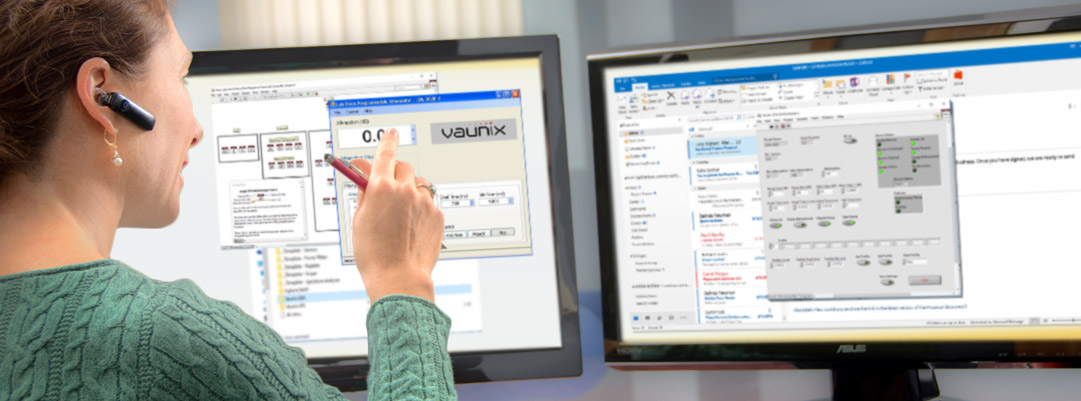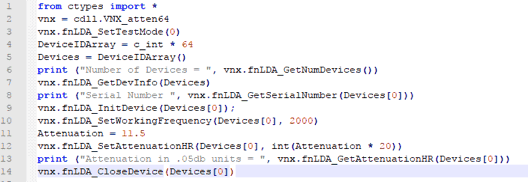
We're your wireless ATE support team
Looking to say "hello" to someone who can help you with saying "good-bye" to wireless signal path problems, test equipment failures, and configuration challenges? Can't find a Lab Brick software set up guide, or need a specific Lab Brick application question answered? You're in the right place. Vaunix provides technical support to our customers and future customer contacts worldwide. We're here to answer the who, what, where, when, why, and how of cellular infrastructure, RF communications, and wireless ATE problems of all kinds, including 5G. We're especially experienced in finding unique ways to employ our portable, programmable devices to create efficient and nimble RF and microwave ATE set ups. Our staff of experienced radio technicians and test engineers is here to help 24/7. Start by reviewing our FAQs, our informative blogs, and our technical resources for immediate insights, and submit your questions directly to our technical team by using the simple form on this page. And if your needs are especially urgent, just call us at 978-662-7839. We look forward to helping you.
Hardware FAQs
Yes. Please send your specific requirements to us.
All Lab Brick products use a rugged aluminum enclosure.
Yes. The user has the option of using either an external 10 MHz reference or the internal reference. This selection is made through the GUI under the settings menu.
Yes. Multiple Lab Brick signal generators can be locked to a common external reference.
Yes, as an example, LMS-203 can be adjusted for an output from -30 to +10 dBm.
We rate the phase accuracy of our Lab Brick phase shifters very conservatively at +/- 2 deg. but it is typically much better. Measured data for an LPS-802, for example, represents typical performance at 5.8 GHz: Error is often less than +/-1 deg. at this and other frequencies. Although there is some variation from unit to unit, error is always very similar (but not guaranteed).
Quite simply -- yes.
Learn more >>
Vaunix Lab Brick phase shifters are conservatively rated. For example, phase accuracy measurement of an LPS-802 at 5.8 GHz shows phase error of less than 1 deg. with a maximum of 1.7 deg.
Software FAQs
As the 802.11ac standard is increasingly becoming the successor to IEEE 802.11n, many customers have asked about the most prudent way to use our attenuators to cover both bands. We have two products for this application each providing attenuation in 0.5 dB steps. Learn more.
The switching speed for the Lab Brick attenuators, shown on our Web site and on our data sheets is defined as the time it takes to change from one attenuation state to another. It does not include the time required to pass the instruction from the computer to the device.
The minimum timing speed of the attenuator is controlled and determined by its firmware along with constraints posed by how the USB bus works, and how the software is implemented in Windows. With the attenuator at the lowest attenuation setting, the process runs each time there is a USB “start of frame” which occurs at exactly 1 kHz. Consequently, the minimum time between any commands is 1 ms, which is also the minimum attenuator dwell and idle time. The fastest the attenuator can ramp and the fastest it can be changed by directly issuing commands to set the attenuator level is thus 1 ms per step.
That said, a USB host controller and its software can potentially send out commands to the device either faster or slower than 1 ms apart. However, exact timing is difficult to define as it depends on many variables including the type of host controller chip, its driver software, and how the application software issues commands. Writing an application to generate a precisely-timed series of USB command outputs is not trivial, but the result would allow the unit to run at near its 1-kHz maximum rate. The response and status messages from the attenuator will not keep up with the output. Vaunix provides .dll files, and drivers for Linux and LabVIEW for developing custom programming interfaces.
Duty cycle can be controlled with the attenuator’s ramp feature. In your example this could be configured using the attenuator’s dwell and idle times along with the attenuator’s bidirectional feature controlled through the user interface software. In addition, the attenuator’s profile function can be used for more complex cycles and it allows 100 discrete steps to be defined at any setting. The profile can be set to run once or continuously.
All of our Lab Brick products can be used with a powered Ethernet-to-USB converter. The phase shifters are specified for operation from 0o C to +50o C and are designed with components rated from -30o C to +70o C. Phase-setting accuracy will degrade slightly over temperature but all other specifications should not vary. We can also sample test or screen units over a specified temperature range if required.
The MTBF of Lab Brick phase shifters is greater than 1.5 million hr., and as they are entirely solid state with no mechanical parts to wear out, their operating lifetime is not affected regardless of how many phase changes are made. The time it takes to switch from one phase to another is up to 4 µs and the user interface allows dwell time to be set between phase changes as fast as 1 ms.
It really depends on the sensitivity of the receiver that you are using, but the LDA-302-P-2 is certainly the attenuator that we would reccomend.
Yes. In fact, there are three ways you can control multiple Lab Brick attenuators:
Method 1: Control multiple attenuators independently
Method 2: Simultaneously control up to eight attenuators
Method 3: Writing your own attenuator control routines
Learn more in our blog on this subject and contact our techincal support team with any questions.
The latest version of the attenuator user interface allows dwell time to be set up to 500s. To learn more about operating or programming Vaunix products or other topics, please contact our technical support team.
We have many customers who use Python scripts to control their Lab Bricks. Our DLLs are designed to be straightforward to use from Python, and, as an example, it only takes a few lines of Python to set the working frequency and attenuation of an LDA-602EH. Here is an example of a Python script which sets the working frequency and attenuation, as well as showing the number of devices connected and the serial number of the first device.

When this script is run with an LDA-602EH attached the output is:

We would be happy to help your programmers understand how to use the Vaunix DLLs.
Yes, all Lab Brick phase shifters can be run from Linux. Learn more in our blog on this subject. If you have any questions about operating or programming Vaunix products or other topics, please contact our technical support team.
It is the policy of Vaunix Technology Corporation to provide Lab Brick users with the latest GUI software, drivers and equipment manuals free of charge. All of this information is available for download from our website. Please visit our support page. Under the Software heading, select the product line. You will need to enter your contact information to proceed. Then you will be able to select the product line and type of software required.
Autonomous operation allows Lab Brick signal generators to operate from a stand-alone power supply or battery pack with or without USB supervision. Lab Brick signal generators will operate normally in the presence of a USB host, however, if DC power is applied and no host is detected, the signal generators will commence operation per user-defined settings. This feature is especially useful in embedded or remote applications where the user does not want to commit a PC or laptop. Battery packs can be purchased from Vaunix.
Software Downloads
- Digital Attenuators
- Signal Generators
- RF Switches
- Phase Shifters
Resources
- Datasheets
- Tech Briefs



